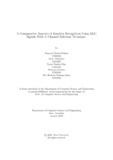| dc.contributor.advisor | Parvez, Mohammad Zavid | |
| dc.contributor.advisor | Abrar, Mohammed Abid | |
| dc.contributor.author | Riduan, Jonayed Ahmed | |
| dc.contributor.author | Mahjabin, Most. | |
| dc.contributor.author | Mim, Nadia Tasnim | |
| dc.contributor.author | Islam, Ridwane-ul | |
| dc.contributor.author | Rana, Md. Shahriar Rahman | |
| dc.date.accessioned | 2021-10-07T03:30:23Z | |
| dc.date.available | 2021-10-07T03:30:23Z | |
| dc.date.copyright | 2021 | |
| dc.date.issued | 2021-01 | |
| dc.identifier.other | ID 17101028 | |
| dc.identifier.other | ID 17101187 | |
| dc.identifier.other | ID 17101487 | |
| dc.identifier.other | ID 17101495 | |
| dc.identifier.other | ID 18201195 | |
| dc.identifier.uri | http://hdl.handle.net/10361/15160 | |
| dc.description | This thesis is submitted in partial fulfillment of the requirements for the degree of Bachelor of Science in Computer Science and Engineering, 2021. | en_US |
| dc.description | Cataloged from PDF version of thesis. | |
| dc.description | Includes bibliographical references (page 35-39). | |
| dc.description.abstract | Emotion can be defined as the neurophysiological changes people experience due to
significant internal or external occasions. This is a mental condition that can a↵ect
a person’s behavior, mood, way of life, and relationship with others. As it directly
a↵ects one’s life, emotion recognition is an important subject in the area of research
field. In recent years, there has been a relentless e↵ort to develop several models
and datasets to detect human emotions and analyze them to understand the depth
of complex human feelings and reduce error in the detection of emotions. To get
better results in recognizing emotion, extensive research is needed to be done on the
feature extraction methods and channel selection. While measuring the performance
of di↵erent classification algorithms, it is very important to compare the results as
well as preprocessing techniques. In this work, we extracted DWT wavelet features
of the EEG channels from the DEAP dataset and used a statistical parameter Root
Sum Square (RSS) to reduce the dimension of the features. Then we applied a
channel selection algorithm on the preprocessed EEG data and selected ten channels
with the highest average power. Finally, we classified positive and negative emotion
related to valence and arousal using di↵erent classification algorithms (like KNN,
RF, Bagging, Extra Tree, AdaBoost and MLP) for the selected EEG channels as
well as for all EEG channels. The accuracy reports achieved for the selected channels
were impressive; the highest test accuracy 67.58% for Valence was retrieved from
the Bagging and Extra Trees classifier while MLP achieved the highest test accuracy
result 63.67% for Arousal. | en_US |
| dc.description.statementofresponsibility | Jonayed Ahmed Riduan | |
| dc.description.statementofresponsibility | Most. Mahjabin | |
| dc.description.statementofresponsibility | Nadia Tasnim Mim | |
| dc.description.statementofresponsibility | Ridwane-ul-Islam | |
| dc.description.statementofresponsibility | Md. Shahriar Rahman Rana | |
| dc.format.extent | 39 pages | |
| dc.language.iso | en | en_US |
| dc.publisher | Brac University | en_US |
| dc.rights | Brac University theses are protected by copyright. They may be viewed from this source for any purpose, but reproduction or distribution in any format is prohibited without written permission. | |
| dc.subject | Emotion recognition | en_US |
| dc.subject | DEAP | en_US |
| dc.subject | EEG | en_US |
| dc.subject | Channel Selection | en_US |
| dc.subject | DWT | en_US |
| dc.subject | RSS | en_US |
| dc.subject | PSD | en_US |
| dc.subject | KNN | en_US |
| dc.subject | RF | en_US |
| dc.subject | Bagging | en_US |
| dc.subject | Extra Tree | en_US |
| dc.subject | AdaBoost | en_US |
| dc.subject | MLP | en_US |
| dc.subject.lcsh | Emotion recognition | |
| dc.title | A comparative analysis of emotion recognition using EEG signals with a channel selection technique | en_US |
| dc.type | Thesis | en_US |
| dc.contributor.department | Department of Computer Science and Engineering, Brac University | |
| dc.description.degree | B. Computer Science | |

